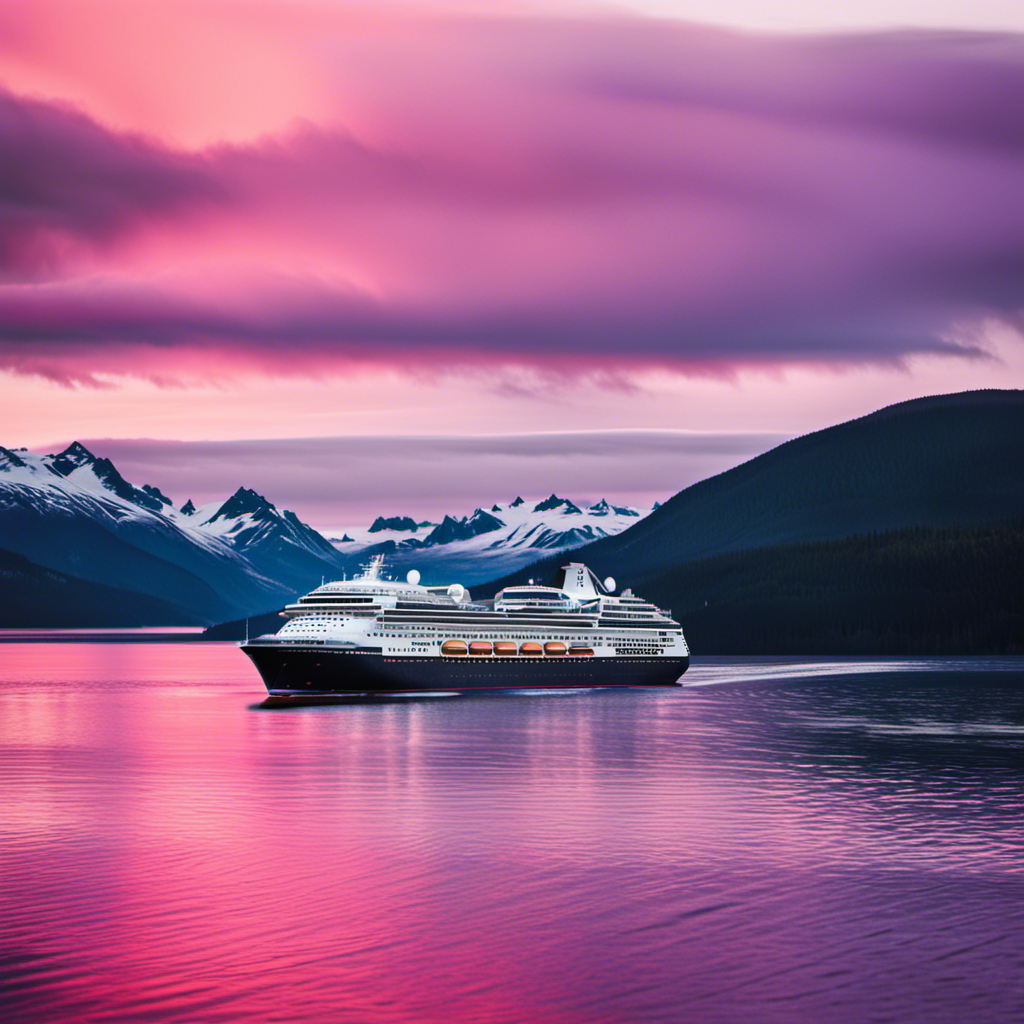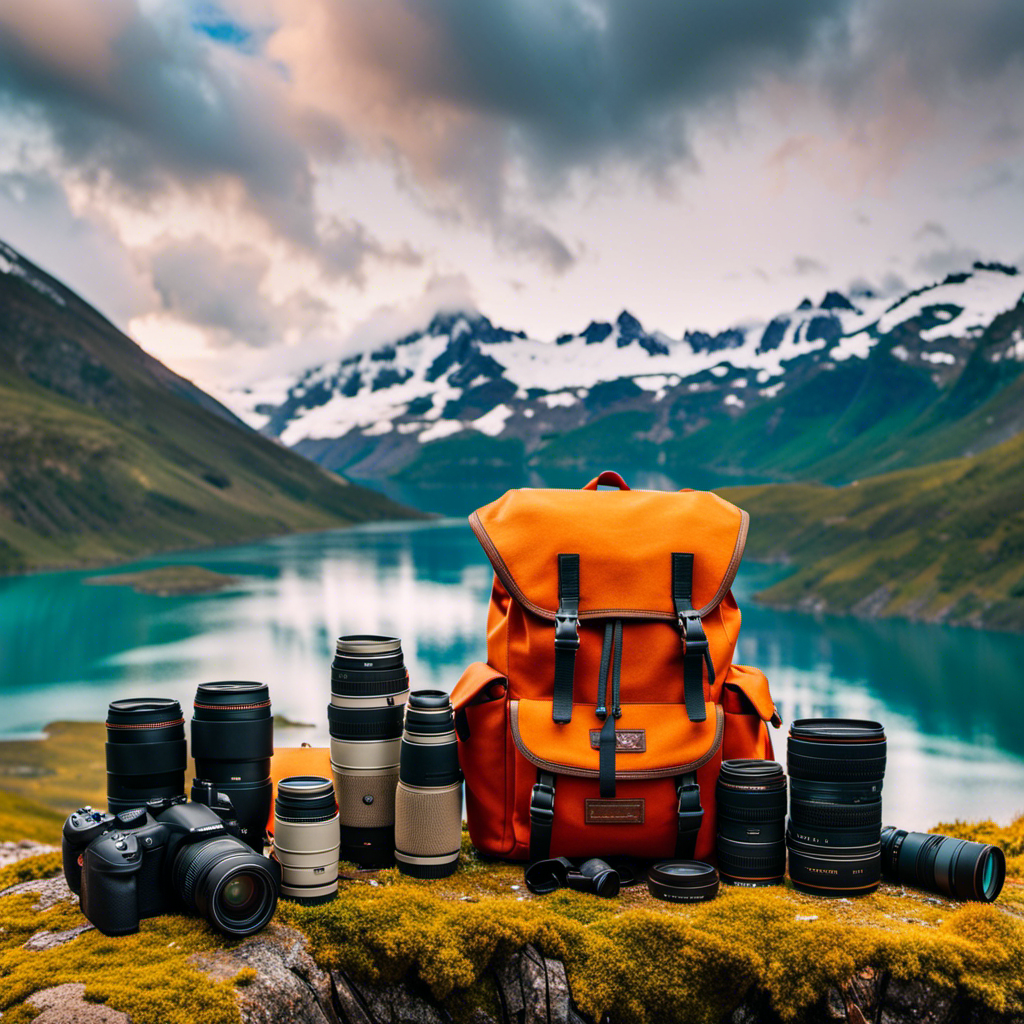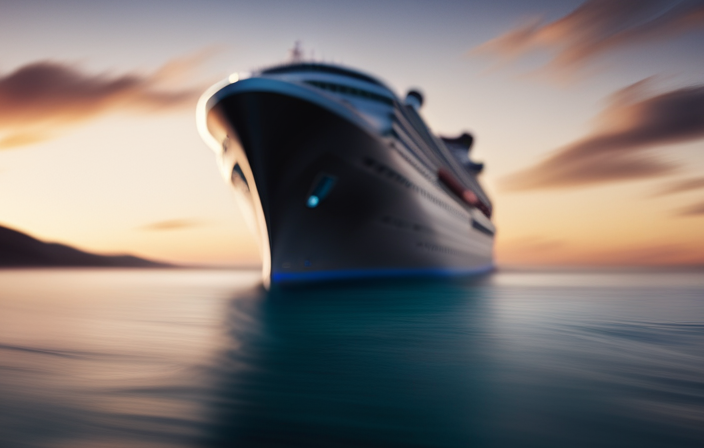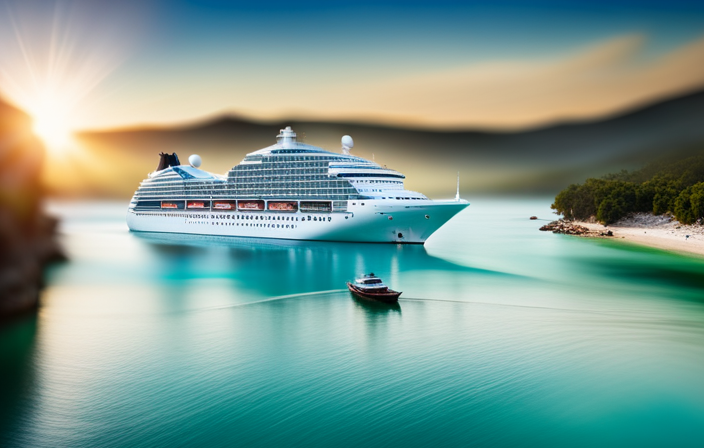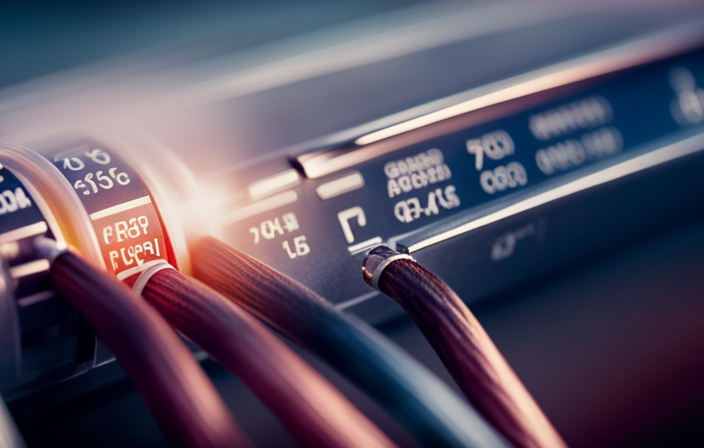As I step out onto the deck of the cruise ship, there’s a sense of anticipation. What kind of weather can we expect in Alaska come September?
I’m here to provide you with accurate and reliable data on the conditions you can expect during your cruise. From average temperatures and precipitation levels to wind speeds and daylight hours, I’ll guide you through the weather patterns you’ll encounter.
So, let’s dive in and discover what Mother Nature has in store for your Alaskan adventure.
Key Takeaways
- September in Alaska has an average temperature of around 50 degrees Fahrenheit, with daily highs and lows ranging from mid-30s to high 50s.
- Coastal areas like Juneau and Ketchikan receive higher amounts of rainfall compared to interior regions like Fairbanks. Coastal areas receive around 2.5 to 5 inches of rainfall, while interior locations receive about 1 to 2 inches.
- September in Alaska can bring strong winds, especially along the coast, with speeds reaching 30-40 knots or more. This can create challenging conditions for cruise ships and affect outdoor water activities.
- Daylight gradually shortens in September as the month progresses, with sunrise and sunset times varying greatly. Limited sunlight can impact outdoor activities and sightseeing, but it is also a great time to view the Northern Lights.
Average Temperature in September
The average temperature in September in Alaska is around 50 degrees Fahrenheit. In terms of clothing options, it is important to pack layers for your cruise. The weather can vary throughout the day, so having the ability to add or remove layers will help you stay comfortable.
September is also a great time for outdoor events in Alaska, as the temperatures are mild and the days are still relatively long. However, it is important to be prepared for potential changes in weather conditions. The scientific language used to describe the weather in Alaska during September includes terms like temperature, precipitation, wind speed, cloud cover, and atmospheric conditions. By relying on weather data and observations, we can provide accurate and reliable information to help you plan your cruise.
Moving on to daily highs and lows…
Daily Highs and Lows
You can expect daily highs and lows in September for your Alaska cruise. The weather in Alaska during this time can vary greatly, so it’s important to come prepared. Here is a table outlining the average temperatures for different regions in Alaska during September:
| Region | Average High Temperature | Average Low Temperature |
|---|---|---|
| Anchorage | 57°F | 44°F |
| Juneau | 58°F | 46°F |
| Fairbanks | 60°F | 38°F |
As you can see, temperatures can range from the mid-30s to the high 50s, depending on the region. It is recommended to bring layers of clothing to accommodate the changing temperatures throughout the day. This could include a light jacket or sweater for cooler mornings and evenings, as well as a t-shirt or light long-sleeve shirt for the warmer afternoons. Now, let’s move on to the precipitation levels during September in Alaska…
Precipitation Levels
In September, Alaska experiences varying levels of rainfall, which can have a significant impact on the weather conditions during a cruise.
Understanding the average precipitation levels for this month is crucial for planning and preparing for any outdoor activities.
By analyzing historical data and observing rainfall patterns, we can gain valuable insights into the weather and rainfall trends in Alaska during September.
This information allows us to make informed decisions and ensure a safe and enjoyable cruise experience.
Rainfall in September
September in Alaska, expect some rainfall during your cruise. As a meteorologist, I can provide you with objective information about the rainfall distribution and its impact on outdoor activities.
September is known for its transition into the rainy season in Alaska, and precipitation levels can vary throughout the state. Coastal areas, such as Juneau and Ketchikan, receive higher amounts of rainfall compared to interior regions like Fairbanks. On average, September sees around 2.5 to 5 inches of rainfall in coastal areas, while interior locations receive about 1 to 2 inches.
The rain can affect outdoor activities, making it important to plan accordingly and bring appropriate gear. However, it is worth noting that the rain also contributes to the beautiful lush landscapes and vibrant wildlife that Alaska is famous for.
Transitioning into the next section on average precipitation levels, let’s dive deeper into the data.
Average Precipitation Levels
When visiting Alaska, be aware that average precipitation levels can vary throughout the state, impacting outdoor activities and creating lush landscapes.
In September, Alaska experiences a transition from summer to fall, resulting in changing weather patterns. The coastal regions, such as Juneau and Ketchikan, tend to receive higher levels of rainfall compared to the interior regions like Fairbanks. This is due to the influence of the Pacific Ocean and the coastal mountains.
Weather forecast accuracy in Alaska can be challenging due to its vast size and diverse terrain. However, meteorological advancements have significantly improved the accuracy of forecasts, providing valuable information for planning outdoor activities during a cruise in September.
Understanding the rainfall patterns and relying on reliable weather forecasts can help travelers make informed decisions and adapt to the changing weather conditions.
Weather and Rainfall
Be aware that rainfall patterns can vary throughout Alaska, impacting outdoor activities and creating lush landscapes. In September, the weather in Alaska can be quite unpredictable. The temperature variations can range from chilly mornings to mild afternoons, with an average high of around 55°F (13°C) and lows hovering around 40°F (4°C). This temperature range can have a significant impact on wildlife, especially those species that rely on specific temperature conditions for breeding or migration. Additionally, the varying rainfall patterns can affect the availability of food sources for wildlife, potentially altering their behavior and habitat preferences. To give you a better understanding of the weather conditions in Alaska during September, take a look at the table below:
| City | Average High (°F) | Average Low (°F) |
|---|---|---|
| Anchorage | 57 | 44 |
| Juneau | 55 | 46 |
| Fairbanks | 59 | 39 |
| Sitka | 57 | 48 |
Now let’s delve into the wind speeds and their impact on the Alaskan weather.
Wind Speeds
You’ll want to know how windy it gets in Alaska during a September cruise. Here are some important points to consider about wind patterns and their impact on cruise ships:
-
Strong Winds: September in Alaska can bring strong winds, especially along the coast. These winds can reach speeds of 30-40 knots or more, creating challenging conditions for cruise ships.
-
Choppy Seas: The strong winds can whip up the ocean, causing choppy seas and potentially leading to motion sickness for some passengers.
-
Stability of Ships: Modern cruise ships are designed to handle rough seas, but it’s important to be aware that the ship may experience some rocking and movement due to the wind and waves.
-
Itinerary Changes: In extreme cases, high winds may force cruise ships to alter their itineraries or skip certain ports for safety reasons.
Considering these factors, it’s advisable to be prepared for windy conditions during an Alaska cruise in September.
Now let’s move on to discuss the daylight hours available during this time.
Daylight Hours
In September, Alaska experiences a significant decrease in sunlight availability due to the change in seasons. The length of daylight gradually shortens as the month progresses, resulting in fewer hours of daylight for cruise passengers to enjoy.
This decrease in sunlight can have an impact on outdoor activities and sightseeing opportunities during a cruise in Alaska.
Sunlight Availability
September in Alaska offers limited sunlight due to the approaching winter season. This has a significant impact on the weather conditions and wildlife in the region.
During this time, the sunrise and sunset times vary greatly, with the days getting shorter as the month progresses. On average, the sun rises around 7:00 AM and sets around 8:00 PM at the beginning of September. By the end of the month, the sunrise is around 8:30 AM and the sunset is around 6:30 PM.
The reduced sunlight affects wildlife behavior, particularly migratory birds and animals preparing for hibernation. They rely on the changing daylight to cue their movements and activities. As the length of daylight decreases, these creatures adapt their behaviors accordingly.
The limited sunlight in September sets the stage for the subsequent section on the length of daylight.
Length of Daylight
In September, Alaska experiences a significant decrease in daylight as winter approaches. The length of daylight gradually shortens throughout the month, with each day getting shorter than the previous one.
This reduction in sunlight has a profound impact on the wildlife in the region. Many animals, such as bears and caribou, begin preparations for hibernation or migration, triggered by the diminishing daylight. The limited hours of daylight also affect the behavior of marine life, such as whales and seals, as they adjust their feeding and breeding patterns accordingly.
It is fascinating to observe how the changing daylight influences the natural rhythms of Alaska’s diverse wildlife.
As we transition into the subsequent section about sea conditions, it is important to note that the shorter days and longer nights also contribute to the overall atmospheric conditions and weather patterns during September in Alaska.
Sea Conditions
You’ll want to be aware of the sea conditions during your Alaska cruise in September. The sea conditions can greatly affect your outdoor water activities and overall experience on the cruise. Here are some key points to consider:
-
Wave Height: In September, the average wave height in Alaska can vary between 2 to 6 feet. However, it’s important to note that waves can occasionally reach higher heights due to storms or strong winds.
-
Water Temperature: The water temperature during this time of year typically ranges from 45 to 55 degrees Fahrenheit. It’s advisable to pack appropriate clothing and gear for any water activities you plan to engage in.
-
Wind Speed: The wind speed can vary throughout the month, but generally, it ranges from 5 to 15 knots. Be prepared for some breezy conditions, especially if you’re planning to spend time on open deck areas.
Considering the sea conditions will help you make informed decisions about your outdoor water activities during your Alaska cruise in September.
Transition: Now that we’ve discussed the sea conditions, let’s move on to the possibility of witnessing the mesmerizing Northern Lights.
Northern Lights Possibility
Now let’s turn our attention to the possibility of witnessing the mesmerizing Northern Lights during your Alaska cruise in September.
Northern Lights, also known as the Aurora Borealis, are a natural phenomenon that occurs when charged particles from the sun collide with atoms in the Earth’s atmosphere, creating beautiful displays of light in the night sky.
Alaska is one of the best places in the world to view the Northern Lights, and September is a great time to catch a glimpse of this celestial spectacle. While the intensity and frequency of the Northern Lights can vary, the best time to see them in Alaska is typically between September and April.
Some of the top Northern Lights viewing spots in Alaska include Fairbanks, Denali National Park, and the Arctic Circle. These areas offer dark skies and minimal light pollution, enhancing your chances of witnessing this breathtaking phenomenon.
As we move on to discussing clothing recommendations, it’s important to be prepared for the ever-changing weather conditions in Alaska.
Clothing Recommendations
Don’t forget to pack layers of clothing to ensure you stay comfortable during your Alaska cruise in September. The weather in Alaska during this month can vary greatly, so it’s important to be prepared for different conditions.
September marks the transition into fall, with temperatures starting to cool down. Average temperatures range from 40°F to 60°F (4°C to 15°C), but it’s not uncommon for temperatures to drop even lower, especially in the evenings. Rainfall is also common, so a waterproof jacket or raincoat is a must. Additionally, packing sweaters, long-sleeved shirts, and thermal underwear will provide extra warmth when needed. It’s always better to have more clothing options than to be caught unprepared.
Now, let’s explore the availability of outdoor activities during your Alaska cruise in September.
Outdoor Activities Availability
There are plenty of outdoor activities to enjoy during an Alaska cruise in September. Despite the potential for cooler temperatures and precipitation, the stunning natural beauty and wildlife sightings make it worth venturing outside. It is important to be prepared with appropriate clothing and gear, as well as being aware of any outdoor activities restrictions that may be in place.
Here is a table summarizing the average weather conditions in Alaska during September:
| Weather Condition | Average Temperature | Precipitation | Wind Speed | Cloud Cover |
|---|---|---|---|---|
| September | 40-60°F (4-15°C) | 2-4 inches | 5-10 mph | 60-70% |
While these are general averages, it is important to note that weather patterns can vary. It is advisable to check the weather forecast before planning any outdoor activities. Wildlife sightings, including whales, bears, and eagles, are common during this time of year, adding to the allure of exploring the outdoors in Alaska.
Frequently Asked Questions
Are There Any Specific Guidelines or Restrictions for Outdoor Activities in Alaska in September?
In September, outdoor activities in Alaska may have guidelines or restrictions due to the weather. It’s important to consider temperature, precipitation, wind speed, and other atmospheric conditions for a safe and enjoyable experience.
How Likely Is It to See the Northern Lights During a September Cruise in Alaska?
It is moderately likely to see the northern lights during a September cruise in Alaska. The best viewing locations are in the northern parts of the state, away from city lights.
What Type of Clothing Should I Pack for a Cruise in Alaska in September?
For a September cruise in Alaska, it’s important to pack cruise fashion and weather accessories. The weather can vary, so bring layers, waterproof gear, and warm clothing to stay comfortable and prepared.
Are There Any Specific Sea Conditions or Concerns to Be Aware of During a September Cruise in Alaska?
During a September cruise in Alaska, it’s important to be aware of potential sea sickness and wildlife sightings. Stay prepared with motion sickness remedies and keep an eye out for incredible wildlife encounters.
What Outdoor Activities Are Typically Available and Popular in Alaska During September?
Outdoor activities in Alaska during September are abundant and popular. Activities such as hiking, fishing, wildlife viewing, and kayaking are enjoyed by many. The beautiful scenery and mild temperatures make it an ideal time for outdoor adventures.
Conclusion
In conclusion, the weather in Alaska during September for a cruise can be quite variable.
One interesting statistic to note is that the average temperature in September ranges from 40°F (4°C) to 60°F (15°C), making it a cool and comfortable climate for outdoor activities.
With precipitation levels averaging around 2.5 inches, it is advisable to bring a rain jacket and waterproof shoes.
Additionally, the possibility of witnessing the mesmerizing Northern Lights adds to the allure of cruising in Alaska during September.

